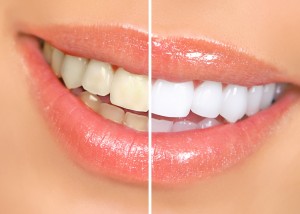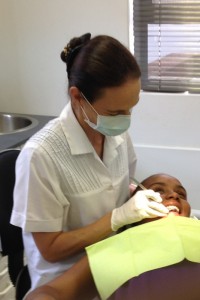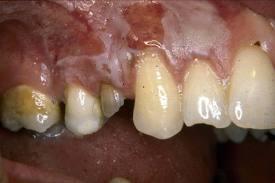It has become very fashionable to whiten teeth, often referred to as dental bleaching. There are many reasons for tooth discoloration and that will determine to a large extend which treatment will suit someone the best. In this website, I will aim to help you understand teeth whitening better, its benefits and risks as well as the best way to whiten teeth.
Teeth whitening may be the most conservative, least invasive way to deal with one or more discolored teeth, as the most common alternatives would be porcelain veneers or crowns. Unfortunately some tooth structure needs to be removed in order to get the required shape and space for the veneers or crowns. If the bleaching doesn’t whiten the discolored teeth enough and you still need to proceed with veneers, the dentist may be able to place thinner veneers as the color you want to mask is not as intense anymore – therefore still less invasive.
Before Bleaching
Before you decide on the best way to whiten teeth, whether it is professional teeth whitening, d.i.y teeth whitening at home or perhaps natural teeth whitening, please consider your options and risks carefully!
I would certainly suggest that you see your dentist for a full dental examination and cleaning (Scale and Polish) before bleaching your teeth. Once the dentist has removed the tartar (calculus) and superficial staining, mostly caused by smoking and certain foods, you may already see a great improvement. The dentist will also need to restore any decayed teeth and fractured teeth or restorations. Any leaking fillings and crowns (that would be where you tooth started to decay between the restoration and the tooth structure) should be diagnosed and treated. Your dentist will probably need to take radiographs of your teeth as a lot of problems may be missed without it. The dentist should also treat gum disease (if present) in order to ensure your mouth is healthy before whitening your teeth.
If your dentist advise you to get crowns, bridges, veneers or fillings, please inform your dentist that you intend to whiten your teeth. Bleaching agents do not bleach restorations, although it may remove some superficial staining. In some cases it may be necessary to do provisional restorations first and complete the final treatment after your teeth whitening. Hopefully this will ensure that you have a good shade match between the restoration and the rest of your teeth. Also keep in mind that bonded composite restorations (tooth colored fillings) should not be done directly after bleaching your teeth as the bleaching gel may cause a less than optimal bond between the filling and your tooth.
Most common risks and side effects caused by teeth whitening:
- Tooth sensitivity, usually hot and cold sensitivity but in some cases teeth can become quite painful.
- Irritation of the gingiva (gums) and other soft tissues of the mouth, often seen when the bleaching agent stays in contact with the gums (often with ill fitting bleaching trays) or when people are sensitive to hydrogen peroxide or carbamide peroxide (which breaks down into hydrogen peroxide). If a very high concentration of hydrogen peroxide is used, chemical burns can be caused.
- Damage to the tooth enamel. Be careful with acidic products such as those containing fruit acids. Brushing with abrasive toothpastes or baking soda can cause abrasion of the tooth surfaces. Prolonged exposure to bleaching agents may also cause damage.
- Severe pain if bleach is used on a decayed tooth.
- Bleaching of teeth is also not recommended in pregnant or lactating women as it hasn’t been established whether this will harm the baby.
- Although some dentist may decide to bleach children’s teeth under exceptional circumstances, this is generally not recommended as they are more likely to get problems with pulp irritation. This is because the pulp chamber (where the tooth’s nerve is) is very large in young children.
- Overbleaching.
- An obsession with tooth whitening.
- Teeth being much whiter than existing veneers, crowns, bridges and fillings. They may even need replacement after the whitening treatment.
- Rebound of the whitened teeth, back to a darker shade. This often happens after quick, intensive in-office treatment as the bleaching is very superficial and some of the whitening is due to dehydration of the teeth rather than actually bleaching them.
- Bleaching agents with more than 16% carbamide peroxide, as high concentrations is likely to cause soft tissue burning. Some products can have carbamide peroxide concentrations of as much as 44%. This is also more likely to cause sensitivity and enamel damage.
Please do not let all these warnings concern you too much!!
Minimize your risks
Just consider your health before deciding on your method of teeth whitening and make sure to choose the best whitening products for your specific requirements. It is usually not ideal to try and whiten your teeth too much too quickly, rather use lower concentrations of bleaching agent over a longer period of time.
Also minimize the risks by only bleaching the teeth requiring bleaching. This is usually the most visible eight front teeth, but in some cases it may only be a single tooth which requires whitening. If it is a single tooth, this tooth can be bleached externally or even internally (from the inside out). This is done on devitalized teeth that often stained due to blood and other fluids. Usually endodontic treatment (also called root canal treatment) would have been done in the past. If not, root canal treatment will need to be done before proceeding with internal bleaching. Some bleaching agent can then be placed inside the tooth – and therefore deal with the deep staining. I will also give advice on specific products, helping you in purchasing the best whitening products suited to your needs.
I hope you will enjoy your new whiter smile!







What are the long-term effects of teeth whitening, since I experienced some sensitivity after whitening my teeth?
The long-term effects of teeth whitening vary from person to person but generally include sensitivity, gum irritation, and potential damage to the enamel of the teeth.
Sensitivity is the most common side effect and can last for a few days to up to a few weeks after whitening. In addition, some people may experience gum irritation or irritation of the soft tissue in the mouth due to the chemicals used in teeth whitening.
Over time, repeated teeth whitening can lead to damage of the enamel on the teeth. It is important to follow the instructions of your dentist or teeth whitening kit to minimize any potential damage.